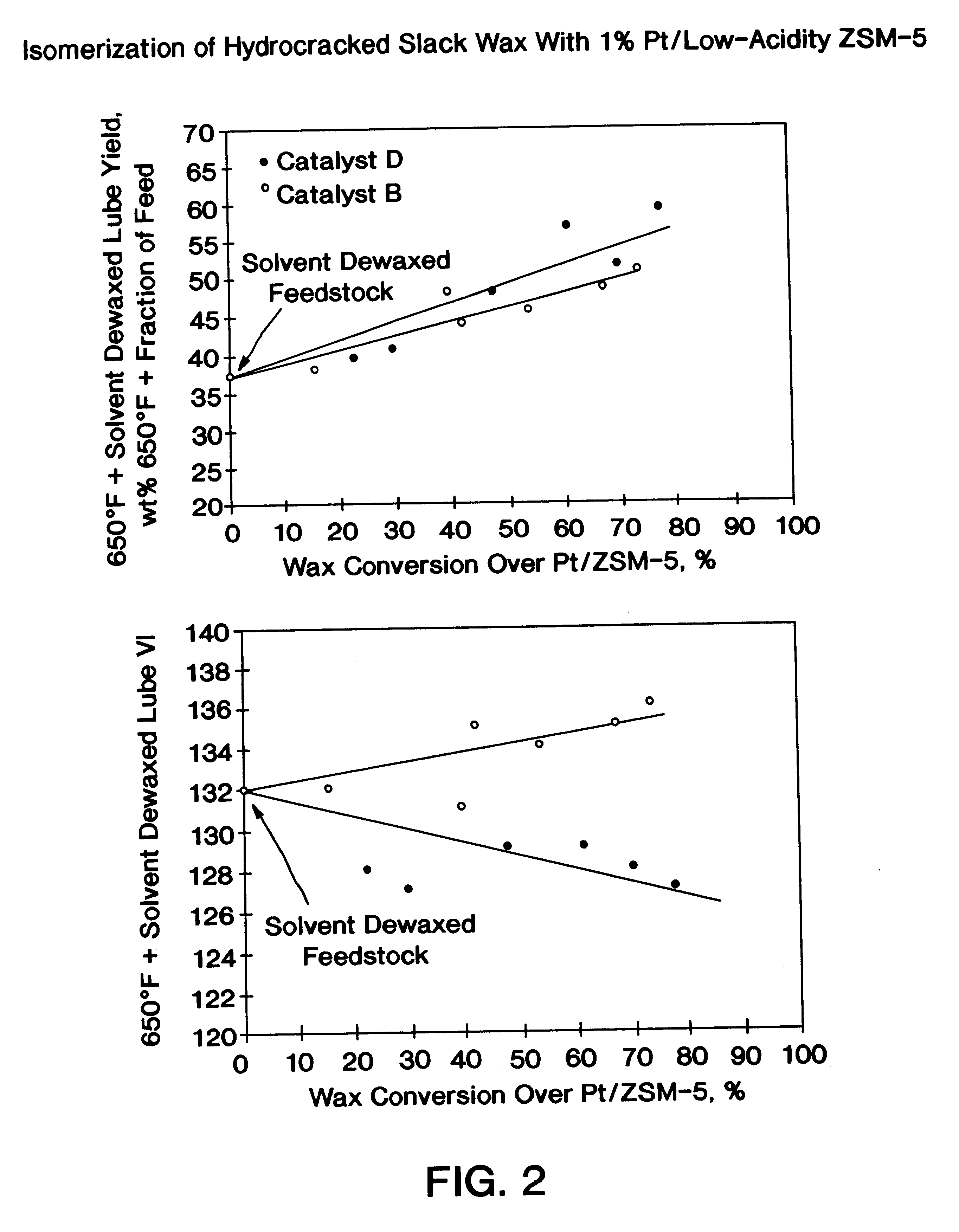Production of high viscosity lubricating oil stock with improved ZSM-5 catalyst
a technology of zsm-5 and lubricating oil, which is applied in the direction of physical/chemical process catalysts, petroleum chemical modification, hydrocarbon oil treatment products, etc., can solve the problems of hazy lube appearance at ambient temperature, high cloud point relative to pour point, and the tendency of vi improvers to undergo degradation, etc., to achieve low pour point, less susceptible to deactivation pore blockage, and high viscosity index
- Summary
- Abstract
- Description
- Claims
- Application Information
AI Technical Summary
Benefits of technology
Problems solved by technology
Method used
Image
Examples
example 1
Catalysts were prepared as follows:
Catalyst A
A low acidity, high dispersion Pt / ZSM-5 / Al.sub.2 O.sub.3 catalyst, Catalyst A, was prepared as follows: A physical mixture of 80 parts ZSM-5, having a silica-to-alumina ratio of 55, and 20 parts pseudobohemite alumina was mulled to form a uniform mixture. All components were blended based on parts by weight on a 100% solids basis. About 2 wt % HNO.sub.3 binding reagent was added to the mixture to improve the extrusion. A sufficient amount of deionized (DI) water was also added to form an extrudable paste. The mixture was auger extruded to 1 / 16" cylindrical shape extrudates and dried at 250.degree. F. The extrudates were then nitrogen calcined at 900.degree. F. for 3 hours followed by air calcination at 1000.degree. F. for 6 hours, and steaming at 1450.degree. F. for 12 hours. The steamed catalyst had an alpha activity of 1. The steamed extrudates were then exchanged with platinum using a 0.0064 M platinum tetraammine(II) chloride solution...
example 2
Commercial grade normal hexadecane purchased from Aldrich was used to evaluate the effectiveness of reduced acidity and metals loading (i.e. metal dispersion) on the hydroisomerization activity and selectivity of ZSM-5 as follows: A 5.7 gram (10 cm.sup.3)sample of Catalyst A was loaded into a 1 / 2 inch diameter fixed-bed micro unit reactor and 80 / 120 mesh sand was added to fill the void spaces. The catalyst was presulfided with 2% H.sub.2 S in H.sub.2 at 700.degree. F. for 2 hrs. Then the reactor was cooled to 535.degree. F. and the n-hexadecane feed was introduced. The pressure was maintained a 1000 psig, the LHSV was 0.4 hr.sup.-1, and the temperature was adjusted to vary the hexadecane conversion. The experiment was repeated for Catalysts B and C, except that with Catalyst C the LHSV was 3 hr.sup.-1, due to its extremely high activity. The isomerization performance results are summarized in Table 2 and FIG. 1.
A review of Table 2 and FIG. 1 reveals that the low acidity Pt / ZSM-5 cat...
example 3
Catalysts B and D were used, respectively, in the fixed-bed reactor of Example 2 to convert a hydrocracked heavy neutral slack wax feedstock. Feedstock properties are listed in Table 3.
5.7 gram (10 cm.sup.3) samples of Catalyst B and D were respectively loaded into the fixed-bed reactor. The catalysts were presulfided with 2% H.sub.2 S in H.sub.2 at 400 psi to a maximum temperature of 700.degree. F. The reactor was operated at a space velocity of 1 hr.sup.-1, a H.sub.2 partial pressure of 2000 psig, and a hydrogen circulation rate of about 4000 scf / bbl. The reaction temperature was varied to effect changes in conversion. The reaction products were distilled to a nominal 650.degree. F. cut point and then solvent dewaxed. The solvent dewaxed oils were analyzed for pour point and viscosities at 40.degree. C. and 100.degree. C. The feedstock of Table 3 was also distilled and solvent dewaxed by the same procedure as a basis to determine the feedstock lube oil yield.
The yield and VI resul...
PUM
| Property | Measurement | Unit |
|---|---|---|
| pour point | aaaaa | aaaaa |
| Viscosity Index | aaaaa | aaaaa |
| pressures | aaaaa | aaaaa |
Abstract
Description
Claims
Application Information
 Login to View More
Login to View More - R&D
- Intellectual Property
- Life Sciences
- Materials
- Tech Scout
- Unparalleled Data Quality
- Higher Quality Content
- 60% Fewer Hallucinations
Browse by: Latest US Patents, China's latest patents, Technical Efficacy Thesaurus, Application Domain, Technology Topic, Popular Technical Reports.
© 2025 PatSnap. All rights reserved.Legal|Privacy policy|Modern Slavery Act Transparency Statement|Sitemap|About US| Contact US: help@patsnap.com



